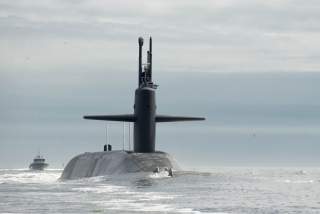The "Super-Fuze": The Big Upgrade to America's Nuclear Arsenal That Russia Fears
"The US military has achieved a significantly greater capacity to conduct a surprise first strike against Russian ICBM silos."
The Department of Energy’s National Nuclear Security Administration (DOE/NNSA)—which develops and builds America’s nuclear arsenal—has completed production of the U.S. Navy’s Arming Fuzing Subsystem for the W76-1/Mk4A Life Extension Program (LEP) warhead.
The new fuze is a key subsystem of the W76-1 LEP, which should extend the life of the original warhead from 20 to 60 years. That gives the 39-year-old weapon a new lease on life. However, arms control experts suggest that the refurbished warheads do not just extend the life of those weapons, instead, they substantially enhance the capability of the 100KT W76-1, which is mounted on the U.S. Navy’s Trident II D5 submarine launched ballistic missile. That means the refurbished weapon is highly destabilizing.
(Recommended: How America Could Go to War with Iran)
“Completing this subsystem is a major achievement for NNSA and the many gifted engineers, scientists and technicians dedicated to serving our vital national security mission through stockpile stewardship,” said Phil Calbos, acting deputy administrator for NNSA’s Defense Programs.
Hans Kristensen, director of the Nuclear Information Project with the Federation of American Scientists (FAS), Matthew McKinzie, director of the Nuclear Program of the Natural Resources Defense Council (NRDC and Theodore A. Postol, professor of science, technology, and national security policy at the Massachusetts Institute of Technology (MIT) describe how the new fuze works in the Bulletin of Atomic Scientists. “Before the invention of this new fuzing mechanism, even the most accurate ballistic missile warheads might not detonate close enough to targets hardened against nuclear attack to destroy them,” Kristensen wrote. “But the new super-fuze is designed to destroy fixed targets by detonating above and around a target in a much more effective way. Warheads that would otherwise overfly a target and land too far away will now, because of the new fuzing system, detonate above the target. The result of this fuzing scheme is a significant increase in the probability that a warhead will explode close enough to destroy the target even though the accuracy of the missile-warhead system has itself not improved.”
(Recommended: Exposed: China's Super Strategy to Crush America in a War)
Kristensen has written extensively about the destabilizing effect of the new so-called “super-fuze.” “The W76 upgrade reflects a 25-year shift of the focus of U.S. hard-target kill capability from land-based to sea-based ballistic missiles,” Kristensen et al wrote. “Moreover, by shifting the capability to submarines that can move to missile launch positions much closer to their targets than land-based missiles, the US military has achieved a significantly greater capacity to conduct a surprise first strike against Russian ICBM silos.”
(Recommended: Japan's Master Plan to Defeat China in a War)
What that means is that from the Kremlin’s point of view, it looks like the United States is trying to develop a nuclear first strike capability against Russia. “The result is a nuclear arsenal that is being transformed into a force that has the unambiguous characteristics of being optimized for surprise attacks against Russia and for fighting and winning nuclear wars,” Kristensen et al wrote. “While the lethality and firepower of the U.S. force has been greatly increased, the numbers of weapons in both U.S. and Russian forces have decreased, resulting in a dramatic increase in the vulnerability of Russian nuclear forces to a U.S. first strike. We estimate that the results of arms reductions with the increase in U.S. nuclear capacity means that the US military can now destroy all of Russia’s ICBM silos using only about 20 percent of the warheads deployed on U.S. land- and sea-based ballistic missiles.”
The Russians do not currently have the ability to monitor launches from around the globe from space. Moscow’s capacity to do so, which dated back to the time of the Soviet Union, has collapsed. Currently, Russia has only two out of twelve nuclear warning satellites in orbit. That means Russian leaders have only 15 minutes of warning before having to decide whether to launch a counter-strike or risk losing their strategic nuclear deterrent.
“The inability of Russia to globally monitor missile launches from space means that Russian military and political leaders would have no ‘situational awareness’ to help them assess whether an early-warning radar indication of a surprise attack is real or the result of a technical error,” Kristensen et al wrote. “The combination of this lack of Russian situational awareness, dangerously short warning times, high-readiness alert postures, and the increasing U.S. strike capacity has created a deeply destabilizing and dangerous strategic nuclear situation.”
That either forces the Russian leadership to launch their weapons first or pre-delegate launch authority down the chain of command—neither of which is good. “Facing the existential threat of a short-warning attack with accurate and powerful sea-launched, nuclear-armed ballistic missiles and no ability to quickly detect their launch with space-based early warning systems, Russian leadership would seem to have little choice but to pre-delegate nuclear launch authority to lower levels of command,” Kristensen et al wrote. “Many possible ways of pre-delegating authority are possible, but none of them are free of dangers that could increase the chances of accidents that could ultimately result in the mistaken launch of Russian nuclear forces.”
And that would be a disaster since even the most capable ballistic missile defenses have little chance at intercepting a modern Russian intercontinental ballistic missile.
Dave Majumdar is the defense editor for The National Interest. You can follow him on Twitter: @Davemajumdar.

